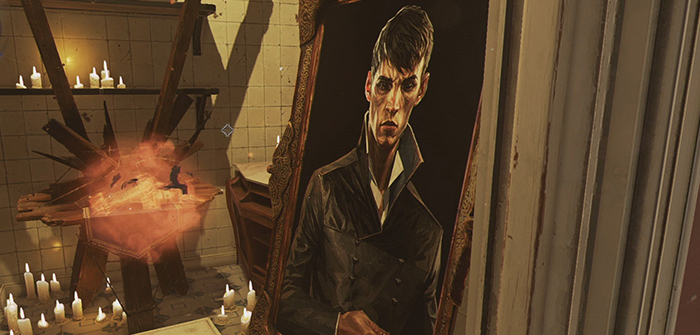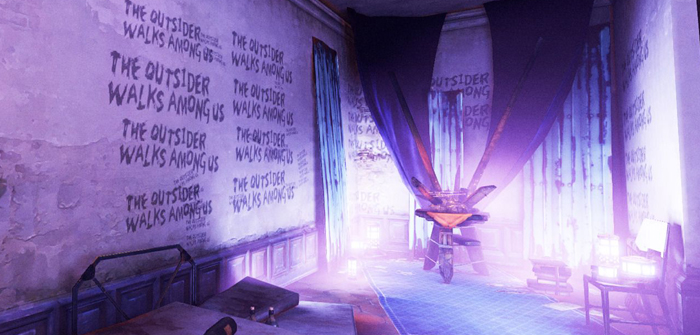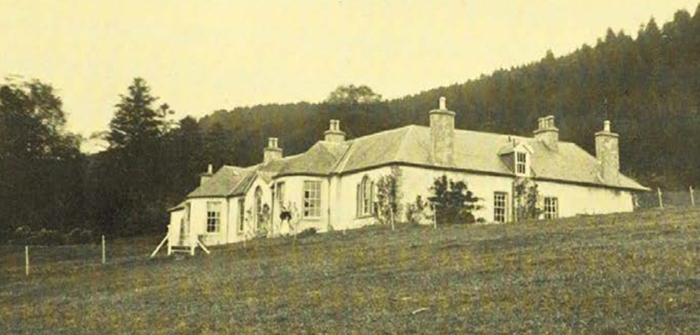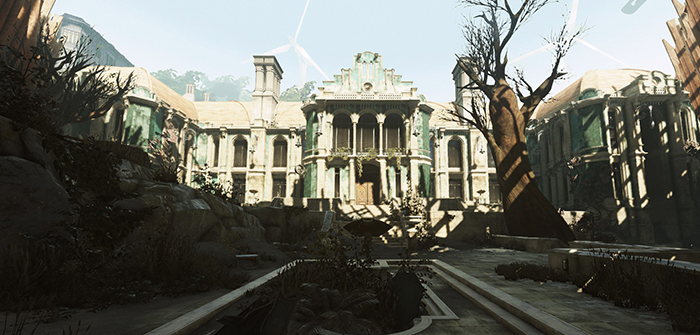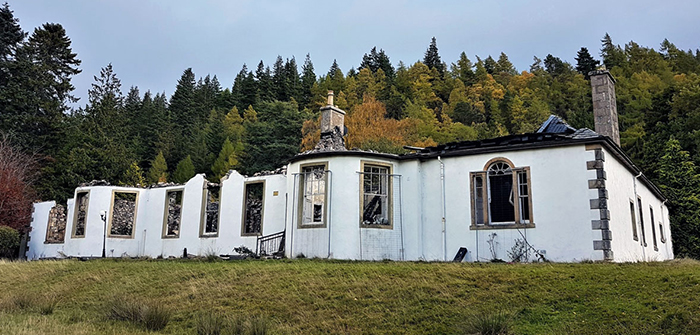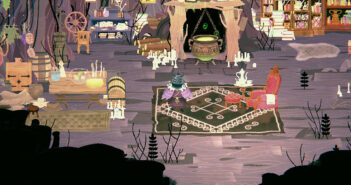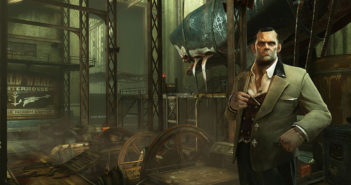Is “A Crack in the Slab” from Dishonored 2 modeled after Aleister Crowley and Boleskine House? If the mission is not an intentional nod to the ceremonial magician from the game’s writers, then it’s an eerie coincidence.
The Dishonored franchise is no stranger to the occult. The series understands the connection between art and magic, personified by the Delilah Copperspoon character (who isn’t unlike Crowley). And the overall atmosphere of magic in the Dishonored games is shadowy and mysterious. It’s all about secretive rituals, graven images, and supernatural happenings that twist and pervert reality. I love it.
As a player, you unlock your supernatural abilities not by plainly leveling up and distributing automatically assigned skill points. Instead, you discover hidden shrines dedicated to the Outsider, who I’ve described in the past as “a dark and mischievous entity who could easily be the mystical lovechild of Philemon and Donnie Darko.”
And it’s at these shrines where you find runes—discs of bone bound in iron and engraved with the Outsider’s Mark. With these fetishes you unlock your supernatural powers as a player. These shrines tend to be hidden and atmospheric. They are secured in secret rooms glowing with ritualistic lighting, and the walls are scrawled with forbidden words.
Much has been made about the weak plot in Dishonored 2—at best it is recycled, borrowing heavily from Dishonored: The Brigmore Witches. But what the game lacks in plot, it makes it up in breathtaking world-building. I challenge you to explore the sunbathed art-nouveau city of Karnaca and not be swept up in the sprawling cityscape.
This is where the “A Crack In The Slab” mission is important, because it tells an unfolding story using the structure and mechanics you play with—much more than the overly praised “Clockwork Mansion” mission. And the closer you get to the chapter’s climax, the more foreboding it becomes.
Occult Workings And Magical Operations
As I played through “A Crack In The Slab” I was immediately in awe of its seamless time-travel mechanism. I was reminded of how the old gothic soap opera Dark Shadows handled time travel. It’s more a tool of sorcery versus scientific breakthrough, freeing it from the rules and regulations that make time travel, well, stupid.
And either by coincidence or synchronicity, I was reading Colin Wilson’s The Occult while playing Dishonored 2. The chapter detailing the life and practices of Aleister Crowley touches upon the occultist’s time at Boleskine House while working the “Abramelin Operation”—a magical ritual where the invoking magician makes contact with his Holy Guardian Angel. But before this can be accomplished, he must summon and bind the 12 Dukes and Kings of Hell to remove their negative influence from his life.
The length of time it takes to prepare this ritual (including prayer from dusk until dawn, bouts of fasting, and celibacy) ranges from six to 18 months, depending on the translation.
And Aleister Crowley, ever the showman, undertook the the Abramelin Operation.
In Colin Wilson’s own words from The Occult:
When [Crowley] moved to a house on the shores of Loch Ness, he called himself Lord Boleskine, or the Laird of Boleskin, and imitated Mathers in adopting a kilt. Here he concentrated upon the magic of Abra-Melin the Mage, whose ultimate aim is to establish contact with one’s Guardian Angel. Crowley states that he and Jones (the alchemist) had succeeded in materialising the helmeted head and left leg of a healing spirit called Buer in London, and that on another occasion an army of semi-materialised demons spent the night marching around his room. In Scotland the lodge and terrace of Boleskin House became peopled with shadowy shapes, the lodgekeeper went mad and tried to kill his wife and children, and the room became so dark while Crowley was trying to copy magic symbols that he would have to work by artificial light, even when the sun was blazing outside.
The Abramelin Operation as it unfolded at Boleskine House and the dark legacy it left on the manor is very similar to what happened at Stilton Manor, where the energies of the Void are twisted and warped because of a seance held on the estate four years prior to the events of the game—the events that freed Delilah Copperspoon from the Void so she could reshape the world.
This last bit is a tad boilerplate, like much of Dishonored 2’s woefully thin plot, but the visuals of Stilton Manor as you approach the seance chamber couldn’t be more exciting. Candles glow around you. Glyphs mark the walls and floor in ghostly blue dye. The very fabric of reality distorts and flickers as the seance opens a gateway into a realm mortals should not tamper with.
This is what’s said to have been Crowley’s downfall in our own world. The Abramelin Operation is supposed to the one of (if not the) most dangerous and taxing magical rituals to undertake, requiring half a year alone to train your body and mind before the real fun begins.
There are many specifications for setting up the ceremonial space to work the Abramelin Operation. I won’t list them all here, save one. You must construct a terrace leading to a spirit lodge. The floor of the terrace is to be covered with a fine river sand. The spirit lodge is where the devils you invoke reside during the Abramelin Operation, and the terrace is their passage to and from your oratory where the ritual is performed. The fine river sand is to reveal the devils’ footprints, which Crowley claims appeared.
A Tale of Two Curses Manors
Meanwhile, in Dishonored 2, the witch Breanna Ashworth, a Delilah Copperspoon loyalist during the events of The Knife of Dunwall and The Brigmore Witches, undergoes a similar ritual at Stilton Manor. And she was successful—the end result of her seance freed Delilah from the Void.
Crowley, too, reported success. He claims his Holy Guardian Angel manifested as the entity Aiwass.
It’s unknown if this being was summoned during the Abramelin Operation or by other means, since Aiwass is said to have materialized himself in April 1904 when he dictated to Crowley the holy book of Thelema, The Book of the Law. But Crowley originally bought Boleskine House in 1899 and probably began the Abramelin Operation between 1899 and 1900.
But during the working, he was called away to London concerning matters involving the Order of the Golden Dawn. The interruption caused Crowley to never banish the dark spirits he originally summoned, leaving them to haunt and torment the property. Some believe this is what caused Crowley’s lifelong downfall and cursed the house since.
This is similar to the spiritual corruption left hanging over Stilton Manor, damning the property after Delilah is freed.
Because of all of these similarities to Boleskine House and Stilton Manor, I find it difficult to believe that Boleskine House did not inspire Stilton Manor in some way.
And if it honestly did not, well, then what does that say about how and why these undeniable similarities occurred to begin with?
To read more about how the connection between art and magic is portrayed in the Dishonored series, please click here.
To read more about how capitalism is portrayed in the Dishonored series, please click here.

